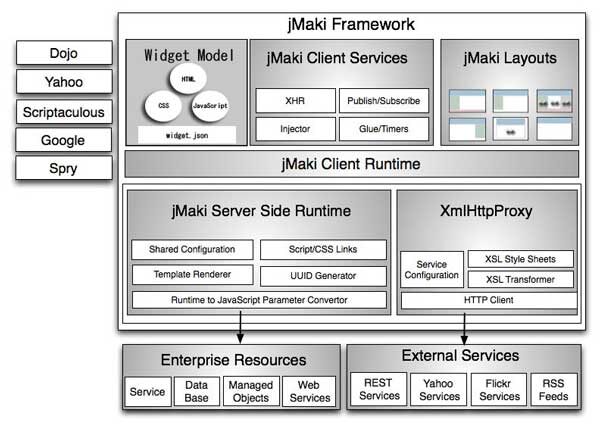jMaki is one of the top notch Ajax Frameworks which render a lightweight model for developing Web Application that are JavaScript centric and Ajax Enabled with the use of various technologies such as Phobos, Java , PHP, Ruby. With jMaki Ajax Framework one can create JavaScript centric web apps by using various widgets widget model , JavaScript Action Handlers , CSS Layouts , different client services such as subscribe events to glue the widgets together or the publish events & a common proxy that is used for interacting with the peripheral RESTful web services.
Despite the fact that jMaki will abstract most of the CSS and JavaScript with the use of default values for widgets, the CSS and JavaScript widgets will be accessible with ease so that the web developers or designers can customize it easily without any hassle. The main focus of jMaki Ajax Framework is to ensure the delivery of the JavaScript to the client so as to make sure that JavaScript is capable of communicating with various server side technologies such as Phobos, PHP , JSF , JSP in a server technology in a unbiased manner.
Though this might sound scary but the fact is that now with the release of jMaki 1.0 version one can add some beautiful and pretty good Ajax components with the cool drag n drop features to the PHP , JSF or JSP pages. You can as well make use of the jMaki with Net beans 5.5 Screen cast and the Eclipse plug-in with the jMaki Framework.
Glance at the jMaki Ajax Framework
jMaki Framework works on the fundamental rule of logic and presentation. The best thing about the jMaki Framework is that with the use of the jMaki Layouts event the most challenged web developers or designers can create highly regarded webpage with reliable standards
If you have a look at the jMaki Architecture above you can notice that there is lot more to learn about the jMaki Framework. The jMaki Ajax Framework functions in a very dense manner and with the use of the jMaki editors it is pretty simple to change the attributes or values of any particular widget just the way you are using any kind of a visual components. Nevertheless if you want to become an expert at using the jMaki Framework and learn more about the elaborate things then you will have to completely dig into the documentation part and then you will actually get to know the power of the jMaki Ajax Framework.
